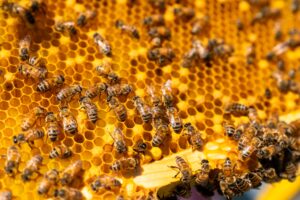Hot potato, cold spaghetti, mashed banana. Whooo, wiggy wiggy wiggy.
Or so the adage goes.
Thousands of millennials around the world grew up dancing to this groovy tune.
But Aussie scientists have had a gut full of this advice from the finger-wagging superstars.
“Wake up, Jeff world!” the scientists yell.
Researchers at ECU and CSIRO have discovered that it is in fact COLD potatoes we should be singing and dancing about, whilst wearing brightly coloured skivvies, if so desired.
RESISTANCE IS NOT FUTILE
Potatoes are like underground storage units for plants.
They are life savers, storing large quantities of starch to help plants survive winter. Also—when shredded, boiled and fried—they help us survive hangovers.
When potatoes are heated, water is absorbed by the starch.
Molecules within the starch get disrupted by this water, changing the potatoes’ texture to familiar, fluffy goodness.

But when your bud the spud gets cool, the starch realigns into crystalline structures.
This cooling, crystallisation process is called retrogradation, and it creates resistant starch. The same thing happens when your bread goes stale.
Normally when you chow down on freshly cooked taters, your body can take their starchy goodness, digest it and transform it into energy that’s used to live.
But it’s a different story once starch forms a resistance.
Our bodies are physically incapable of digesting resistant starch.
But that doesn’t mean it’s no good for us.
I’D (BUTY)RATE THAT
While we can’t digest resistant starch, our gut bugs love it.
Researchers have found that friendly bacteria in our large intestine actually ferment resistant starch, feeding off it. In the process, they release things called short-chain fatty acids.
One particular fatty acid, butyrate, seems to be useful in lowering our risk of colorectal cancer.
This buty-licious fatty acid feeds the cells that line your colon, helping them to stay healthy.
It has also been shown to programme cell death in cancerous colorectal cells, which is big news for our butts.
SOME CRAP STATS
Colorectal cancer is the second leading cause of cancer deaths in Australia.
Traditionally, we’ve been told to up our fibre intake to stave it off. This fibre, which remains undigested by both us and our microbes, is important for bulking up our bowel movements and keeping us regular.
And Aussies seem to have taken this to heart. Generally, over the last 20 years, our fibre consumption has increased.
But our rates of bowel cancer have not dropped accordingly.
So what are we missing?
Increasingly, it seems this resistant starch is the missing ingredient in our resistance against cancer.
In fact, British researchers have found that starch consumption has a stronger association with reduced risk of bowel cancer than the traditional fibrous fix.
NOT SO SMALL POTATOES
Now, the CSIRO recommends that we all increase our intake of foods that are high in resistant starch.
And here’s where The Wiggles got weirdly close to the mark, all the way back in 1994.
CSIRO’s website lists cold pasta and bananas as ideal foods to bump up your gut’s butyrate and potentially lower your risk of developing colon cancer.
CSIRO advises that bananas should be firm—once they ripen, they have less resistant starch. But that doesn’t mean you can’t also follow The Wiggles’ advice and have your bananas mashed.
Other foods high in resistant starch (and not listed by The Wiggles) include legumes, oats and some wholegrain products.
It’s important to note that researchers do not suggest dumping fibre in favour of resistant starch. For healthy bowels, we need a bit of both.
Moral of the story? Keep your potatoes cold, your dance moves fresh and your risk of colon cancer low.









